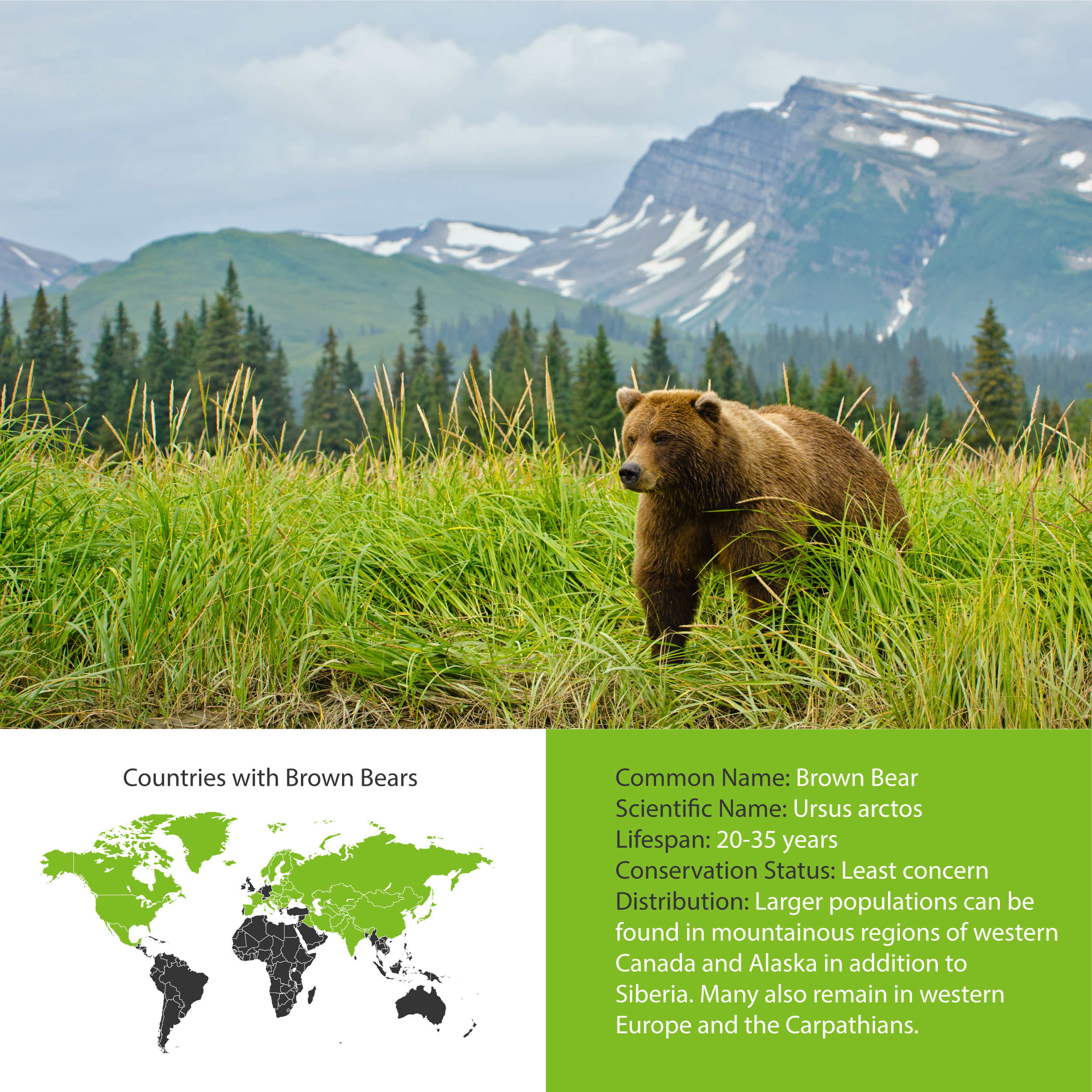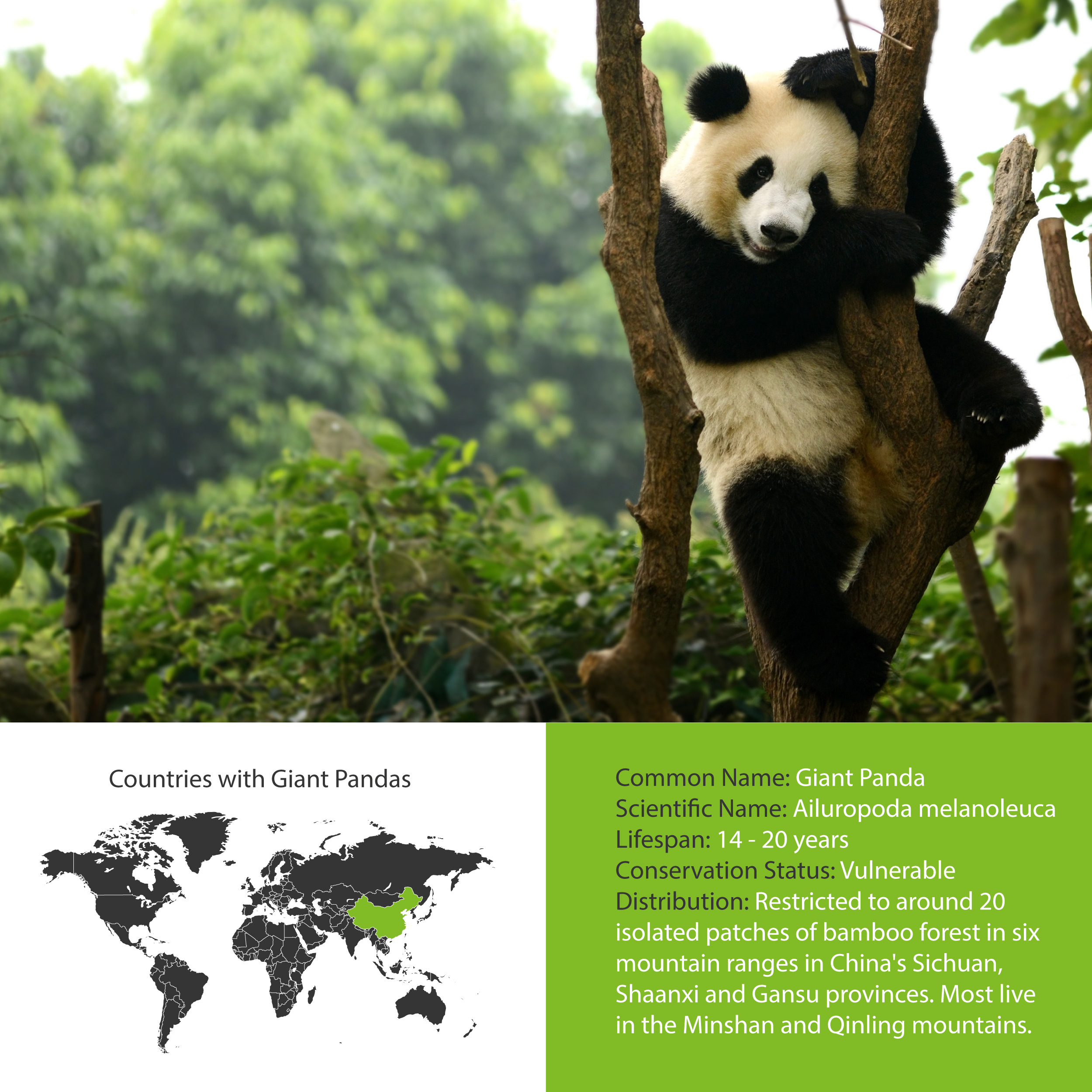This edition of (The Real) Fantastic Beasts and Where to Find Them will focus on bears! These immensely powerful yet cuddly-looking critters can be found roaming the forests, mountains, deserts and tundra of four different continents. This small group of mostly large omnivorous mammals has been divided into eight different species, all of which we take a closer look at below.
Brown Bear
With a population of over 200,000, Brown bears are one of the most numerous and undoubtedly the most widespread of the bear family. Like many species, they have been divided into subspecies which include the famous Grizzlies that prowl the forests and mountains in the interior of North America. Contrary to popular belief, Grizzlies are so-called not due to their temperament, but for their white or tan-tipped fur (“Grizzly” means sprinkled or streaked with grey). Other subspecies can be spotted in the mountainous regions of southern and western Europe and across most of Asia.
Giant Panda
Perhaps the most celebrated of all bears due to their striking pattern and friendly nature, the Giant Panda population is restricted to a few isolated patches of bamboo forest across six mountain ranges within China. Enormous conservation efforts have helped to ensure that the Giant Panda has been saved from the brink of extinction, but the species’ conservation status is still listed as vulnerable. In 2014, a nationwide census recorded 1,864 wild Giant Pandas with much of their overall population remaining in zoos and specialized sanctuaries.
Polar Bear
The largest of all bears and the biggest land predator that roams the earth today, the Polar bear is one of the most iconic species on the planet. They are considered as marine mammals due to the fact that they live most of their lives on the sea ice of the Arctic Ocean. While there population is estimated at 22,000 – 31,000, their numbers are rapidly decreasing due to loss of habitat caused by climate change. Despite their appearance, Polar bear fur is actually transparent and is made up of an outer layer of long 5-15 cm guard hairs and a thick undercoat of short insulating hairs.
Sloth Bear
Easily distinguishable against other bears for their shaggy hair and white U-shaped marking across the chest, Sloth bears are a long and stocky species that can be found in only four countries – Bhutan, India, Nepal and Sri Lanka. This relatively small species also sports a pale muzzle and well-developed hook-like claws that are perfectly suited to climbing trees and digging up their termite prey. Despite an estimated 7,000 – 10,000, spotting a Sloth Bear in the wild can be tricky, owing to the fact that they’re a predominantly nocturnal species.
Spectacled Bear
South America’s only living bear species, the spectacled bear is so named for its distinctive beige-coloured facial pattern which sometimes extends down the neck. Also known as the Andean Bear, they can be found only in the Andean region of South America which spans across Argentina, Venezuela, Colombia, Ecuador, Peru and Bolivia. The Spectacled Bear is technically the largest carnivore on the South American continent, but the fact their diet is made up of only around 5% meat, causes most to award the title to the Jaguar. Their population is estimated at between 6,000 – 10,000 individuals.
Asiatic Black Bear
The Asiatic Black Bear is similar in appearance to the brown bear, but is easily distinguished for its smooth black fur coat and white V-shaped fur pattern on its chest. There are no accurate estimates of their population, with the species listed as a vulnerable by IUCN. Despite the lack of knowledge regarding their numbers, they are relatively widespread. Asiatic Black Bears can be found in many areas across Asia from mainland countries including Iran, Pakistan and China to island nations such as Japan and Taiwan.
Sun Bear
The Sun Bear, (also known as the honey bear) is the smallest of all in the taxonomic family and also happens to be the rarest of all bear species. It is estimated that the population of Sun Bears has decreased by 30% over the past 30 years due to habitat destruction. Despite their low numbers, Sun Bears are relatively widespread across the forests of Southeast Asia, with the densest population found in Cambodia’s Mondolkiri Province.
North American Black Bear
With an estimated population of up to 600,000 individuals, the North American Black Bear is the most numerous bear species on the planet. Along with the brown bear, they are the only member of the bear family to be listed as least concern by IUCN. One of the densest concentrations of North American Black Bears lie in the state of Maine, USA with around 30,000 individuals. The species has been divided into several subspecies, including the Louisiana Black Bear, Florida Black Bear and Mexican Black Bear.
All photos are Shutterstock. Graphics by Leigh Woods.








